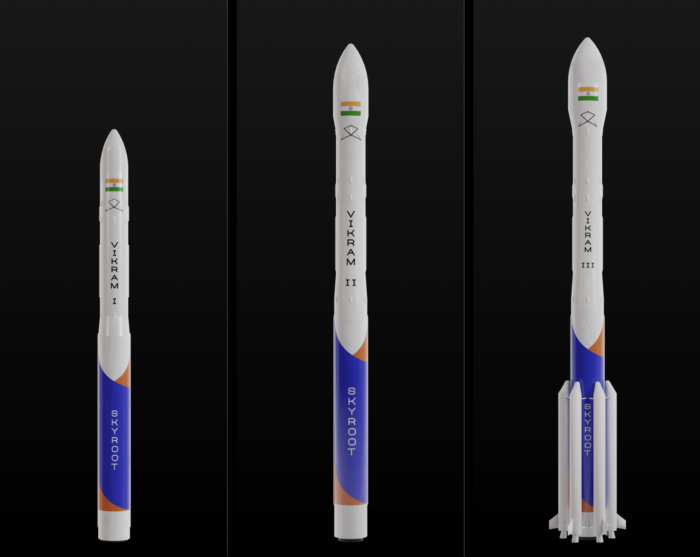by Julia Seibert
A less ambitious actor might have settled with the fact that accounting for 2% of the US $370 billion global space industry of 2020 is not a bad deal. Not India though. The country, taking note of the field’s potential, plans to turn its formerly US $7 billion space sector into a US $50 billion one by 2024, requiring it to overhaul its space landscape and embrace commercialization by private entities. A comparable strategy worked wonders on the US’s programs, bringing about a thriving industry, countless satellites in orbit, and launches at bargain prices. Might India be eyeing similar goals?
Though Indian space activities date back to the 1960s, its programs have been mostly government-centered. The Indian Space Research Organization (ISRO) – the country’s space agency, operating under the Department of Space (DoS) – has long been the country’s sole launch provider. Two types of expendable medium-lift rockets, the Polar Satellite Launch Vehicle (PSLV) and the Geosynchronous Satellite Launch Vehicle (GSLV), have been the agency’s workhorses for decades, and a new Small Satellite Launch Vehicle (SSLV) was recently introduced.
A Reusable Launch Vehicle (RLV), which looks like a mini space shuttle, is also in development. Throughout their existence, the two veteran rockets launched projects including two lunar missions and one Martian and over 424 satellites originating from 34 different countries. The Antrix Corporation was established by the government in 1992 to deal with such foreign or commercial ventures (though Antrix was replaced by NewSpace India Limited, or NSIL, in 2019). These governmental customers might have been enticed by the fact that while expensive, ISRO’s payload-to-orbit price was still on the lower side.
Then came SpaceX. Armed with unbeatable prices, it soon became the leading global provider for commercial launches, hoovering up 65% of the global market share in 2018. Trailing behind it are a string of fledgling companies hoping to accomplish the same. With the industry flocking to pastures cheaper, India recognized the need for action – especially considering that around the same time, a young generation of space startups began gearing up. While ISRO has long been outsourcing work to private companies in India (as of 2013, around 400 companies frequently contracted for the agency), this was not enough; a commercial industry was needed to cut costs and keep pace with the modern landscape.
2020 saw a wave of deregulations hit the sector, opening the door to private space companies in India. The Indian National Space Promotion and Authorisation Centre (IN-SPACe), an agency operating under the DoS, was also established. IN-SPACe would serve as the link between commercial and government ventures, with the aim to ‘enable and facilitate the participation of private players’ by ‘promoting’ and ‘supervising’ the building of satellites and launch systems, and allow commercial entities to use ISRO infrastructure. The Indian Space Association (ISpA), a coalition of Indian space companies, was formed a year later to form the ‘voice of the industry’. Several companies have since risen to prominence, and their existence is still supported today by India’s 2023 Space Policy.
Table of Contents
ToggleTop Private Space Companies in India
1. Skyroot Aerospace
Hyderabad-based Skyroot, established in 2018, became the first startup to partner with ISRO when the agency agreed in 2021 to allow it ‘access to ISRO’s facilities and expertise towards the development and testing of subsystems and systems of space launch vehicles’. The Indian private space company specializes in launch vehicles and is working on a series of cost-efficient, non-reusable rockets, called Vikram, specializing in the launch of small satellites (smallsats).

The company’s website boasts that its rockets would need little launch infrastructure and a vehicle could be made ready to launch within 72 hours. So far, the firm has only launched Vikram-S, a suborbital vehicle, which became the first privately manufactured Indian rocket when it took off in November 2022. Still, the company has been feverishly testing engines to be used on later orbital models and plans to launch again sometime in 2023, hoping to achieve a cadence of twice a month by the end of 2025.
Visit company’s profile page.
2. Bellatrix Aerospace
Bellatrix initially had their fingers in two pies: satellite propulsion and rocket propulsion. Soon, however, their focus turned to R&D (research and development) and orbital maneuvering, so their methane-guzzling rocket was scrapped. The Bengaluru-based private company, founded in 2015, most recently launched its Hall effect thruster – an engine using an electric field for propulsion, minimizing reliance on traditional fuels and providing a high specific impulse, or efficiency – aboard a PSLV, with partial success. In 2021, Bellatrix signed a Memorandum of Understanding (MoU) with Skyroot, which would allow Bellatrix’s Orbital Transfer Vehicle (OTV) to fly aboard a Vikram I rocket. Such a vehicle can taxi payloads to orbits that might be inconvenient for a rocket to reach, broadening both companies’ customer bases.
Visit company’s profile page.
3. Dhruva Space
Dhruva are satellite experts, offering a ‘full-stack’ system that includes satellite platforms, launch solutions, and orbital deployment, as well as ground services. Founded in 2012 and headquartered in Hyderabad, Dhruva has a handful of missions under its belt, which tested its orbital deployment method and satellite platform. This Indian space company also became one of the first to sign an MoU with IN-SPACe for its deployment demonstration, which came months after signing a launch agreement with NSIL. It also entered into a host of MoUs with other companies to further the reach of its technology, including Skyroot and two French companies.
Visit company’s profile page.
4. Agnikul Cosmos
With a name derived from a Sanskrit word meaning ‘a place where people learn to use fire’, the company sets a high standard – and their product certainly sounds ambitious. Agnikul, founded in India in 2016, hopes to create an 18-meter-tall rocket (Agnibaan, meaning ‘arrow of fire’) that, much like a Lego model, can be rearranged depending on its payload. The rocket can fly payloads from 25 to 100 kg, powered by four to seven engines. The rocket normally consists of two stages, with the option of a third ‘baby stage’ to be squeezed inside the payload fairing. It comes complete with a mobile launch pedestal (Dhanush, or ‘a celestial bow’) that, the company claims will allow access to over 25 launch ports. Its Agnite engines, electric-pump-fed and running on kerolox, will be completely 3D-printed. Agnikul has also entered into a MoU with DoS in 2021, allowing the company access to ISRO infrastructure.
Visit company’s profile page.
5. Pixxel
Snapping images of Earth from orbit is bog-standard work for satellites – but Pixxel’s come with a twist. The company’s small, 15-kilogram satellites capture images in hyperspectral frequencies, allowing analysis ‘in 100s of wavelengths rather than 10s of wavelengths as done today.’ This can lay bare features unidentifiable by run-of-the-mill satellites, such as vegetation patterns, emissions, and ore deposits in up to five-meter resolution. Pixxel also offers access to its data platform, which promises ‘near real-time insights’ and ‘specialized machine-learning algorithms’.

The young Bengaluru-based private company was only founded in 2018, but already won over Google as an investor during a particularly tough time for space startups, making it the highest-valued space company in India. Previously, the company had even signed an agreement with the US’s mysterious NRO. Though three satellites are currently in orbit and six more are to launch this year, Pixxel’s plans involve larger constellations of around 24 satellites, with later generations to swarm out into the solar system to scan alien worlds for resources.
Visit company’s profile page.
You may also like:
Top Private Space Companies [sorted by sector]
Top 15 Best Space Companies in the World
The 10 Best Space Companies to Work for in 2023
Areas of Focus for Indian Private Space Companies
Not to state the obvious, but Indian private space companies are largely focusing on two areas: satellites and their launch. There are several good reasons for this. First off, launching satellites is inherently cheaper and much less risky than launching humans. There is also more money to be made: the satellite industry generated US $279 billion in global revenue in 2021, and it is predicted that 1,700 of them will be launched per year by 2030. It goes without saying that the orbiting machines are vital to modern life, with capabilities like Earth observation, espionage, television, GPS, and many forms of communications relying on them. This is unlikely to change, and developments such as technology miniaturization bring orbit within the reach of more companies. More compact designs mean lighter satellites which in turn means less cash needed to launch them.
Speaking of which, low launch prices arising out of novel technology further increase accessibility. Countless companies are already getting in on the action, to the point where a launch shortage is already underway and few companies keeping up with SpaceX’s cadence and prices. It might still be a while before the aforementioned Indian startups are ready to fill this void and provide some much-needed competition, but they have a few things going for them. India has a history of pulling off space missions at fractionally lower costs than NASA (as reported by Vice), and it seems future generations recognize the importance of this tradition: Skyroot centers its whole rocket around cost efficiency, as does Agnikul. Without reusability, can the designs really compete though? Assembling a rocket in days, as Skyroot intends to do, and a quick launch cadence are must-haves, and India’s huge workforce and cheap labor could give them the edge over similar companies in the UK or US. The concept seems to hold water; customers are already crawling out of the woodwork, with over 400 allegedly interested in Skyroot’s work.
What makes Indian private space companies promising in this respect is not just the cost efficiency, but also the availability of launch infrastructure and fully-formed launch vehicles. This sets the country’s industry, including Indian private space companies, apart from places like Europe, which has little of either, or the UK, whose northern inclination reduces what it can launch and where. Though the PSLV and GSLV are not reusable and are certainly pricier than the likes of SpaceX, they exist – and they work. Even now, while privately developed Indian rockets are taking their baby steps, non-launcher space companies like Dhruva and Bellatrix have used an ISRO rocket to get their payloads to orbit. More importantly, however, the existing infrastructure and expertise inherent in the country’s industry is fertile soil for young companies in India to grow from and makes establishing a private industry much cheaper.

Upcoming Launches by Private Space Companies in India
India’s private space companies are still a little on the young side to produce consistent launches. Since products are still in development, launch dates are prone to slipping and are not always announced far in advance. One launch happening in the possible near future is Skyroot’s Vikram 1, planned for 2023. Agnikul had targeted an Agnibaan launch in March 2023, which, after not materializing, might still happen later this year. Pixxel is also preparing six satellites for a 2023 launch, though details are once again hazy. Bellatrix and Dhruva both already test-launched their systems in 2023, so it may be a while before these are tweaked and standardized for consistency.
Notable Indian Space Projects and Achievements
While the fledgling Indian private space industry is finding its feet, its governmental counterpart boasts an impressive history of spaceflight. The hundreds of satellites launched by ISRO, both foreign and domestic, constitute only part of the agency’s resume. Chandrayaans 1 and 2, India’s lunar missions, were launched in 2008 and 2019, respectively. The second even included a lander and rover, though a software glitch caused a hard landing and marked a swift end to the lander’s mission. The third lunar mission is planned for 2023. India’s Mars Orbiter Mission (MOM) entered orbit successfully in 2014, making the country the first to achieve this on its first go. The whole thing cost only US $74 million, compared to the US $582.5 million NASA spent on the MAVEN orbiter that same year. Other projects include a balloon launch base used to study cosmic rays and an orbiting observatory called Astrosat. An Astrosat-2, a further Mars mission, probes to Venus, Jupiter, and asteroids, and a solar observatory have all been suggested. India also has a human spaceflight program in the works (with a joint NASA-ISRO mission to the ISS planned for 2024) and has joined NASA’s Artemis Accords.
Funding Sources for the Private Space Sector
India’s private space sector is funded overwhelmingly by private investments. Space business is risky, and blowing up one’s rocket while trading publicly might not be so great for the company’s stocks – especially for a startup. As a result, startups such as the above often rely on Venture Capital funds (VCs), which have such financial perils ingrained in their very DNA and lend themselves well to the high-risk, high-reward nature of the industry. Bellatrix, for example, raised money by impressing investors including BASF Venture Capital GmbH, Inflexor Ventures LLP, StartupXseed, Pavestone Capital, Mankind Pharma Family Office, Survam Partners, and Karsemven Fund. Skyroot secured funding from GIC, Singapore’s sovereign wealth fund, and Pixxel enticed Google.
As of 2023, Indian private space startups have been granted US $220 million in VC funding since 2011 (the total may be much more; as reported by Arab News, the Indian Space Association’s director general Lt. Gen. Retd. Anil Kumar Bhatt estimated that US $240 million in investments was raised since 2020). The bulk of investment really only happened within the roughly three years since the Indian private industry was even officially established, and US $119 million was invested in 2022 alone. For that short a timeframe and so young an industry, that is not bad.
Since India’s governmental space sector is still much further developed than the private, it is not yet common for it to hand out missions to companies just starting out. This is not to say that there is no compensation; for example, the government offered millions in investments to private space companies capable of increasing India’s crop yield. As noted here, ISRO has a lot less cash to throw around than, say, NASA, its average annual budget being just US $1.45 billion (compared to NASA, whose budget steadily resides in the US $20 billion). Still, governmental support need not only be monetary; perhaps the biggest gesture of assistance was the industry practically rearranging itself to allow private actors a foot in the door. Once the startups get their ducks in a row, contracts from ISRO and even other countries (such as the NRO contracting Pixxel) might become more customary.
You may also like:
The 20 Most Important UK Space Companies
Space Companies in Canada and Their Industry Contribution
Most Exciting NewSpace Companies to Look Out for in 2023
Future Prospects for the Private Space Sector in India
So, will India achieve its goal of a US $50 billion space industry by 2024? Probably not – it looks to be more to the tune of US $13 billion by 2025. Still, almost doubling the industry in five years is no small feat, and this is owed to the country paying attention to global trends and leveraging existing infrastructure and talent. The latter, for that matter, is one thing India has in spades. As described in detail by Times of India, the country has the largest youth population in the world (808 million under 35) and thousands of engineering and technical colleges. According to Professor Rajesh Khanna, president of India’s NIIT University, these schools churn out 1.5 million engineering graduates a year, but engineering is now losing its place as a highly sought-after career and only a fraction of graduates end up employed.
Might the growing private space industry help soak up some of this overflow? The sector is still new and these trends take a while to manifest, but the potential is there: in 2022, India harbored the third-largest startup ecosystem in the world, and, according to finance minister Nirmala Sitharaman, produced the second-most amount of CEOs in the world after the US. The patterns are reflected in the private space industry, with the number of space startups jumping to over 100 in the year following the first deregulations (47 added in 2021). As of June 2023, almost 200 Indian private startups in the ‘space technology’ category exist (not counting those falling under different categories but still contributing to the industry), though not all are registered with the country’s Department for Promotion of Industry and Internal Trade (DPIIT).
Despite the somewhat optimistic outlook, there are some possible caveats. ISRO, for example, might not be thrilled at sharing its monopoly, and laws regarding private companies are still vague. As noted by Space Review, Indian governmental entities still dominate the field of intellectual property in space, and competition from these entities could result in an unlevel playing field for private space companies. Also, unlike the US model, all Indian space activities are regulated by the DoS and ISRO (whereas in the US, NASA and the Space Force do not dictate private actors’ activities unless they are under contract). As described in a report by the Center for Strategic and International Studies, ISRO’s control might restrict private players’ activities, especially since the agency’s commercial arm NSIL (formerly Antrix) could be a direct competitor.
Whether or not Indian private space companies overcome such obstacles remains to be seen. If ambition was the only factor, the country would have long met its US $50 billion industry target.
If you found this article to be informative, you can explore more current space news, exclusives, interviews, and podcasts.
Featured image: P90 Micro Sat. Credit: Dhurva Space
Share this article:








